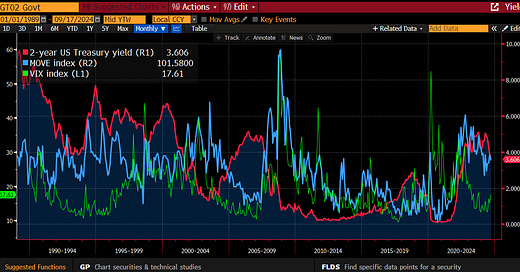September FOMC reflections
I am teaching fixed income to students this fall. Last Wednesday, I told students we would need to watch for late breaking press from the WSJ as is typical before a Fed meeting. But, the large shift in rate cut expectations on Friday and over the weekend from 25 bps to 50 bps due to articles in the press still caught us a bit by surprise.
Tomorrow will be one of most obvious starts to a central bank easing cycle. That was the Fed’s Jackson Hole message.
However, the market is unclear what to expect from the September FOMC meeting though it leans towards 50 bps given the abundance of former FOMC members speaking up for 50 bp in the WSJ, FT and various op-eds. The actual FOMC is in blackout — so we won’t know what they all really think until tomorrow afternoon.
Going on the assumption that the recent rise in the probability of a 50 bps rate Fed cut is not a pure accident or miscommunication, let’s consider arguments for and against a 50 bps Fed rate cut.
Some arguments for a 50 bps rate include:
the rise in real interest rates as headline inflation has come down over recent quarters even as the nominal Fed funds rate has stayed constant;
risk management related to the Fed’s full employment mandate;
China deflation risks; and
market pricing now tilts towards a 50 bps rate cut so an unfavorable market reaction to a smaller rate cut could tighten US financial conditions and be self-defeating.
Some arguments against 50 bps rate cut include:
uncertainty about the sign on Fed policy transmission — higher interest rates post pandemic have been associated with stronger aggregate economic growth/not weaker US growth as many initially expected/ could lower interest rates increase savings and weaken consumption?;
risk management related to the Fed’s inflation mandate as much of the improvement in US inflation relates to external factors (China, commodities) and further fiscal stimulus may come after the US election;
it is possible that the natural interest of interest has increased after the pandemic so that higher real interest rates are appropriate; and
larger expected Fed rate cuts (particularly when poorly communicated) may increase bond market volatility which, in turn, tends to lead volatility higher in other financial markets, including equities.
In the vein of what will the Fed do, it seems plausible that the first two arguments “for” a larger 50 bps Fed rate cut are well-worn ways of Fed thinking and may be sufficient to carry most in the FOMC.





